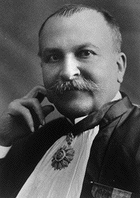

(Carcassonne, 5 Nov 1854 – Toulouse, 14 Aug 1941)
Sabatier was born in Carcassonne (France) where he had the first part of his secondary education before moving in Toulouse. He was admitted to the Ecole Normale Supérieure at 20 and became graduated “agrégé” three years later, the first of his class. Encouraged by Berthelot, he entered his laboratory at the Collège de France and get his doctorate in physical sciences in 1880. After one year at the Bordeaux university, he obtained the chair of chemistry at Toulouse in 1884. He had chosen to perform all his works in this town despite several opportunities at the Sorbonne or the Collège de France.
His first researches were within the thermochemical tradition of Berthelot’s laboratory and included among others analyses of metallic and alkaline-earth sulfides and chlorides, isolation of selenides of boron and silicon and the partition of a base between two acids. In 1895 he begun the preparation of metals by reduction of their oxides with hydrogen and, thus, succeeded one year later in fixing nitrogen on various metals (Cu, Ni, Co and Fe).
His main discovery in the field of hydrogenation of organic molecules was to obtain ethane resulting from the reaction of nickel oxide with hydrogen at 300°C and then with a current of ethylene:
“Action du nickel sur l’éthylène. Synthèse de l’éthane. Note de MM. Paul Sabatier et J.-B. Senderens. C. R. Acad. Sci. Paris, 1897, 124, 1358-1360“
Later, he succeeded the same reaction with various unsaturated hydrocarbons such as benzene, toluene, xylene, and nitrobenzene. He showed also that at high temperature his procedure would lead to dehydrogenation and he applied the reaction to the production of aldehydes and ketones from their corresponding alcohols. Most of the subsequent work by Sabatier between 1897 and 1905 dealt with hydrogenation in the vapor phase and hence could not directly be applied to nonvolatile molecules such as glycerides and other fats.
For all his researches Sabatier was awarded the 1912 Nobel Prize in chemistry which he shared with the other famous French chemist Victor Grignard.
His first book “La catalyse en chimie organique” appeared in 1913 but was translated in English in 1923 and later revised and reprinted in 1965 (Catalysis Then and Now, Palisades Park, NJ). It contains the description of the Sabatier’s theory of catalytic mechanism which was later named “chemisorption”.
The work of Sabatier contributed to the foundation of important industries of the 20th century but he paid himself little attention to the practical developments of his discoveries.
DISPERSIVE LIQUID-LIQUID MICROEXTRACTION
Lire la suiteDevenez membre et participez au développement de la Lipidomique au XXIème siècle.
S'inscrire